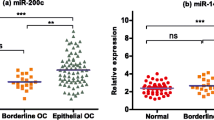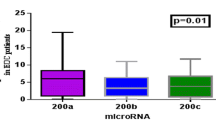Abstract
Aim
Epithelial ovarian cancer (EOC) is the most ominous tumor of gynecological cancers due to its poor early detection rate and unfavorable prognosis. To date, there is no reliable screening method for the diagnosis of ovarian cancer at an early stage. MiRNAs are small non-coding RNA molecules, and their main function is to regulate gene expression. The present study compared the serum miR-1181 and miR-4314 levels in patients with EOC and healthy controls to measure the diagnostic and prognostic value as candidate biomarkers.
Materials and methods
We collected serum samples from a total of 135 participants (69 patients with EOC and 66 healthy controls). Relative expressions of miR-1181 and miR-4314 were measured by quantitative real-time polymerase chain reaction assay (qPCR).
Results
The present study revealed that both serum miR-1181 and miR-4314 levels in patients with EOC were significantly increased compared to healthy controls for each marker. In addition, there was a significant relationship between miR-1181 and miR-4314 overexpressions and the stage and prognosis of the disease. Finally, patients with high expression levels of miR-1181 and miR-4314 had significantly shorter survival rates than those with low expression levels.
Conclusion
The current study proposed that serum miR-1181 and miR-4314 could discriminate the EOC patients from healthy controls. In addition, both miR-1181 and miR-4314 may be predictive biomarkers for ovarian cancer prognosis. Further studies are needed to confirm the findings of the present study.





Similar content being viewed by others
Data availability
The data that support the findings of this study are available on request from the corresponding author. The data are not publicly available due to restrictions e.g. their containing information that could compromise the privacy of research participants.
References
Minareci Y et al (2022) Prolongation of neoadjuvant chemotherapy before surgery: seeking the optimal number of cycles in Serous Ovarian Cancer. Chemotherapy 67(1):1–11
Doubeni CA, Doubeni AR, Myers AE (2016) Diagnosis and management of Ovarian Cancer. Am Fam Physician 93(11):937–944
Elias KM, Guo J, Bast RC Jr. (2018) Early detection of Ovarian Cancer. Hematol Oncol Clin North Am 32(6):903–914
Zhao L et al (2022) The role of miRNA in Ovarian Cancer: an overview. Reprod Sci 29(10):2760–2767
Song Z et al (2019) MicroRNA-1181 supports the growth of hepatocellular carcinoma by repressing AXIN1. Biomed Pharmacother 119:109397
Kafshdooz L et al (2018) The role of microRNAs and nanoparticles in ovarian cancer: a review. Artif Cells Nanomed Biotechnol 46(sup2):241–247
Zhang HY et al (2015) Activation of ARK5/miR-1181/HOXA10 axis promotes epithelial-mesenchymal transition in ovarian cancer. Oncol Rep 34(3):1193–1202
Ruan L et al (2018) Serum miR-1181 and miR-4314 associated with ovarian cancer: MiRNA microarray data analysis for a pilot study. Eur J Obstet Gynecol Reprod Biol 222:31–38
Weber JA et al (2010) The microRNA spectrum in 12 body fluids. Clin Chem 56(11):1733–1741
Xiao YF et al (2013) microRNA detection in feces, sputum, pleural effusion and urine: novel tools for cancer screening (review). Oncol Rep 30(2):535–544
Mishra S, Yadav T, Rani V (2016) Exploring miRNA based approaches in cancer diagnostics and therapeutics. Crit Rev Oncol Hematol 98:12–23
Wang W et al (2022) Integrated analysis of ascites and plasma extracellular vesicles identifies a miRNA-based diagnostic signature in ovarian cancer. Cancer Lett 542:215735
Zavesky L et al (2015) Evaluation of cell-free urine microRNAs expression for the use in diagnosis of ovarian and endometrial cancers. A pilot study. Pathol Oncol Res 21(4):1027–1035
Fukagawa S et al (2017) MicroRNA-135a-3p as a promising biomarker and nucleic acid therapeutic agent for ovarian cancer. Cancer Sci 108(5):886–896
Kim S et al (2019) Serum exosomal miRNA-145 and miRNA-200c as promising biomarkers for preoperative diagnosis of ovarian carcinomas. J Cancer 10(9):1958–1967
Shi M et al (2018) MicroRNA-200 and microRNA-30 family as prognostic molecular signatures in ovarian cancer: a meta-analysis. Med (Baltim) 97(32):e11505
Zhu T et al (2017) A pilot study of circulating MicroRNA-125b as a diagnostic and prognostic biomarker for epithelial ovarian Cancer. Int J Gynecol Cancer 27(1):3–10
Wang W et al (2019) Five serum microRNAs for detection and predicting of ovarian cancer. Eur J Obstet Gynecol Reprod Biol X 3:100017
Kminkova J et al (2014) Identification of novel sequence variations in microRNAs in chronic lymphocytic leukemia. Carcinogenesis 35(5):992–1002
Adam-Artigues A et al (2021) Identification of a Two-MicroRNA signature in plasma as a Novel Biomarker for very early diagnosis of breast Cancer. Cancers (Basel), 13(11)
Dyba T et al (2021) The European cancer burden in 2020: incidence and mortality estimates for 40 countries and 25 major cancers. Eur J Cancer 157:308–347
Siegel RL et al (2023) Cancer statistics, 2023. CA Cancer J Clin 73(1):17–48
Webb PM, Jordan SJ (2017) Epidemiology of epithelial ovarian cancer. Best Pract Res Clin Obstet Gynaecol 41:3–14
Peres LC et al (2019) Invasive epithelial ovarian Cancer survival by Histotype and Disease Stage. J Natl Cancer Inst 111(1):60–68
Fortner RT et al (2023) Characterization of ovarian cancer survival by histotype and stage: a nationwide study in Norway. Int J Cancer 153(5):969–978
Matz M et al (2017) Worldwide comparison of ovarian cancer survival: histological group and stage at diagnosis (CONCORD-2). Gynecol Oncol 144(2):396–404
Davidson B, Trope CG, Reich R (2014) The clinical and diagnostic role of microRNAs in ovarian carcinoma. Gynecol Oncol 133(3):640–646
Di Leva G et al (2013) Estrogen mediated-activation of miR-191/425 cluster modulates tumorigenicity of breast cancer cells depending on estrogen receptor status. PLoS Genet 9(3):e1003311
Peter ME (2010) Targeting of mRNAs by multiple miRNAs: the next step. Oncogene 29(15):2161–2164
Saito T, Saetrom P (2010) MicroRNAs–targeting and target prediction. N Biotechnol 27(3):243–249
Cai H et al (2013) Plasma microRNAs serve as novel potential biomarkers for early detection of gastric cancer. Med Oncol 30(1):452
Shao C et al (2019) The value of miR-155 as a biomarker for the diagnosis and prognosis of lung cancer: a systematic review with meta-analysis. BMC Cancer 19(1):1103
Liu F et al (2021) Prognostic value of miR-1181 in non-small cell lung cancer and its regulatory effect on tumor progression. Exp Ther Med 22(5):1284
Hua X, Fan KC (2019) Down-regulation of miR-1181 indicates a dismal prognosis for nasopharyngeal carcinoma and promoted cell proliferation and metastasis by modulating Wnt/beta-catenin signaling. Eur Rev Med Pharmacol Sci 23(3):1077–1086
Jiang J et al (2015) MiR-1181 inhibits stem cell-like phenotypes and suppresses SOX2 and STAT3 in human pancreatic cancer. Cancer Lett, 356(2 Pt B): p. 962–970
Wang J et al (2017) miR-1181 inhibits invasion and proliferation via STAT3 in pancreatic cancer. World J Gastroenterol 23(9):1594–1601
He B et al (2020) miRNA-based biomarkers, therapies, and resistance in Cancer. Int J Biol Sci 16(14):2628–2647
Hill M, Tran N (2021) miRNA interplay: mechanisms and consequences in cancer. Dis Model Mech, 14(4)
Oom AL, Humphries BA, Yang C (2014) MicroRNAs: novel players in cancer diagnosis and therapies. Biomed Res Int 2014:p959461
Gao YC, Wu J (2015) MicroRNA-200c and microRNA-141 as potential diagnostic and prognostic biomarkers for ovarian cancer. Tumour Biol 36(6):4843–4850
Funding
This research was supported by the Scientific Research Project Unit of Istanbul University (Project number: TSA-2019-35361). No other specific grant was received from any funding agency in the public, commercial, or not-for-profit sectors.
Author information
Authors and Affiliations
Contributions
Y. Minareci: Project development, data collection, data analysis, manuscript writing and editingN. Ak: Project development, data analysis, manuscript editingH. Sozen: Project development, supervisionO. A. Tosun: Data collectionC. Kucukgergin: Project development, data management, manuscript editingA. F. Aydin: Project development, data management, manuscript editing, İ. Bingul: Data management, M.Y. Salihoglu: Project development, supervision S. Topuz: Project development, supervision.
Corresponding author
Ethics declarations
Ethical approval
The instutional review board and ethics committee of Istanbul University approved our study protocol (ethics number: 1119, date: 08/2019).
Competing interests
The authors declare no competing interests.
Additional information
Publisher’s Note
Springer Nature remains neutral with regard to jurisdictional claims in published maps and institutional affiliations.
Rights and permissions
Springer Nature or its licensor (e.g. a society or other partner) holds exclusive rights to this article under a publishing agreement with the author(s) or other rightsholder(s); author self-archiving of the accepted manuscript version of this article is solely governed by the terms of such publishing agreement and applicable law.
About this article
Cite this article
Minareci, Y., Ak, N., Sozen, H. et al. The evaluation of miR-1181 and miR-4314 as serum microRNA biomarkers for epithelial ovarian cancer diagnosis and prognosis. Mol Biol Rep 51, 515 (2024). https://doi.org/10.1007/s11033-024-09464-y
Received:
Accepted:
Published:
DOI: https://doi.org/10.1007/s11033-024-09464-y




